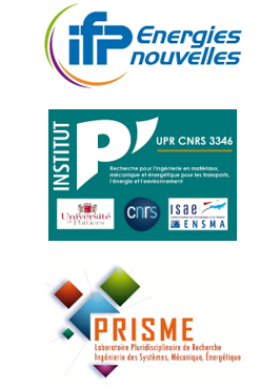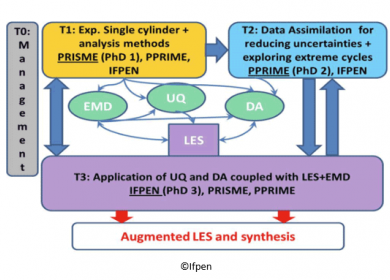Augmented prediction and anaLysis of massive data for the idEntification of Key parameters Controlling Internal Aerodynamics.
|
Project supported by the National Research Agency |
|
| Duration ► | 48 months |
| Start ► | August 2021 |
| ANR funding ► | 572k€ |
Context
Electrification of vehicles and improved efficiency of internal combustion engines (ICE) are the main levers to reduce greenhouse gas emissions. Recent studies indicate that in 2040 thermal cars sales will still remain an important part of the market and the spark-ignition engine (SIE) is seen as the most interesting ICE technology.
However, technological challenges must be tackled before meeting real driving emissions expectation due to the diversification and complexity of hybrid applications. For flow aerodynamics, mixing and combustion down to the individual engine cycle, challenges are for example associated to robustness of concepts on a cycle basis, rapid variations of engine loads observed in hybrid technologies during transients, the occurrence of extreme cycles for a wider range of operating conditions. Numerical, experimental and analyzing tools have made significant progress in recent years for the analysis of spatial and temporal scales of the unsteady in-cylinder flows.
Large-Eddy Simulation (LES) is an essential tool for the design of robust concepts. While LES has been validated against well-defined experiments, the prediction of internal turbulent dynamics and combustion during a cycle is affected by epistemic uncertainties. Therefore, progress is still needed to obtain optimal and robust design.
Objectives
The main objective of ALEKCIA is to develop game-changing tools for augmented prediction and analysis of turbulent reactive flows with a focus on real spark-ignition engine operations fueled with hydrogen to better capture time-resolved events and increase understanding and control of the origins of undesired behaviors. The key hypothesis is that future progress and success is tied to the synergistic, strong combination of experimental and numerical tools at every stage of the project, which will provide advancement in the analysis of physical scales and boundary conditions (BCs).
The major scientific challenges addressed by ALEKCIA are to :
- quantify and reduce uncertainties (UQ) due to model parameters and BCs,
- develop new Data Assimilation (DA) approaches for coupling LES with experimental measurements,
- develop new decomposition methods to analyse big data generated by LES and high-speed PIV,
- combine them with UQ and DA methods for detailed analysis of individual SIE cycles during steady operations and fast transients.
We stress that this methodology could also be used more widely for industry and energy applications.
Partners
► IFP Energies Nouvelles
► L'institut PPRIME/CNRS (Poitiers)
► Le laboratoire PRISME (Université d'Orléans)
Work Plan
To achieve its ambitious objectives, work in ALEKCIA is structured into one management task (T0) and three technical tasks (T1 to T3). We will address non-cyclic phenomena under transient and fired operations and develop novel analysis from the acquired experimental and LES databases of a SIE performed respectively at PRISME (T1) and IFPEN (T3) laboratories.
The partners of the project will also collaborate on the development of crank-angle resolved spatio-temporal EMD decomposition (T1 and T3) for engine flows to obtain an unprecedented detailed understanding of the mechanisms involved in the generation of in-cylinder flow, turbulent dynamics and their impact on combustion.
The development of UQ tools to quantify and reduce uncertainties in complex LES of SIE flows is also targeted (T3). Finally, the capabilities of DA methods to calibrate realistic BCs on-the-fly is investigated by PPRIME (T2 and T3). This task is particularly relevant when assimilating experimental data (in the form of BC and in-cylinder large-scale flow patterns from EMD) obtained in extreme cycles.
EMD obtained from a selected number of measured cycles presenting very slow or fast combustion rates will be coupled with UQ and DA tools for their inclusion in LES (T3). In this scenario, LES will be able to properly follow the assimilated aerodynamic behaviour of these cycles while turbulent dynamic will be modelled. Finally, the application of the developed tools will allow to identify the main key parameters controlling internal aerodynamics.
Contact : Fabrice FOUCHER ⇒ fabrice.foucher@univ-orleans.fr



